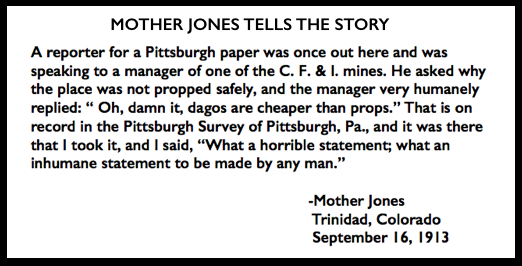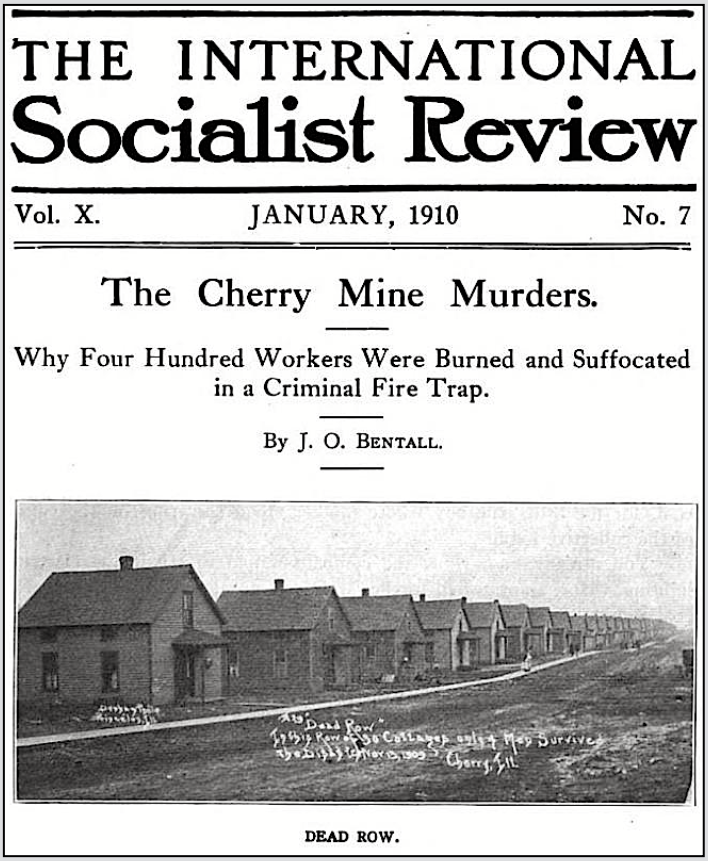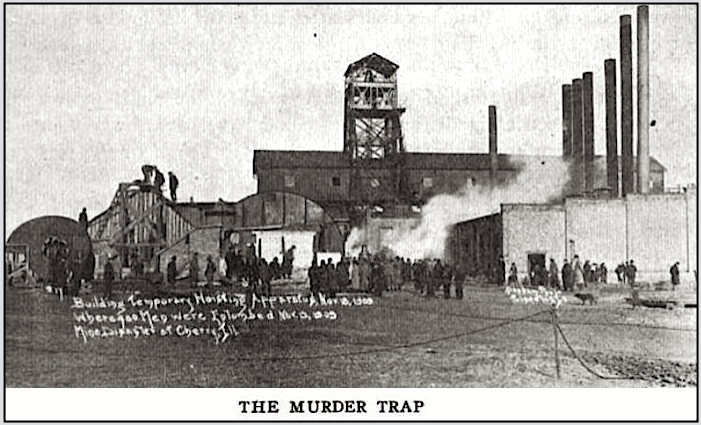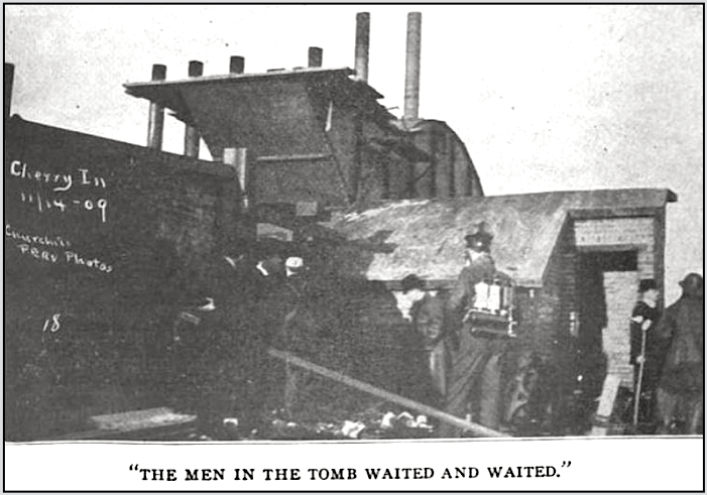 ———-
———-
Hellraisers Journal – Friday January 7, 1910
Cherry, Illinois – Scene of Mass Murder of Men and Boys, Part I
From the International Socialist Review of January 1910:
[Part I of II.]
AS your brother one of the four hundred who perished in the Cherry coal mine November 13th? Or was it your father? Your husband? Your son? My brother was there. My father. My son. I helped carry them out. They were cold in death. They were covered with coal dust and swollen from black damp.
I am telling you this story from what I have seen with my own eyes. Not from hearsay.
I went from Chicago right to Cherry. With thousands of others I stood and looked from the outside. Then I broke through the line and joined the volunteer rescuers. I put on overalls, jacket, cap and lamp and went down into the tomb that contained over four hundred victims—a few living, most of them dead.
I helped plug the entries to prevent the fire from spreading. I had a hand in timbering where the roof was loose, or where collars were breaking. I cut legs off the dead mules so we could get them through the passageways and clear the track for bringing out the men. I was with the gang that found nineteen dead in one pile and twenty-one in another, thirty-seven in a third and one hundred and sixty-two in a fourth.
We took those men—our brothers—and loaded them into the cars-eight or ten of them into each car. We pushed them a mile, a mile and a half, through the tunnels to the shaft and brought them up. We laid them on canvas in rows on the ground—in rows eighty, a hundred feet long. We carried them on stretchers, made of scantlings and coarse canvas, into the morgue. We put them into pine coffins—cheap boxes—furnished by the company. We brushed away a tear occasionally as the body of our brother was hauled off to the long trench—the ditch—dug for him and the others, for the old man whose gray hair was black with coal, for the little pale boy whose mother stood shivering on the edge of the collective tomb.
You already know how the company failed to repair the electric lighting. How unprotected torches were put up along the tracks where coal and hay was pushed. How the bales brushed the torches and caught fire. How little boys under legal age were made to do this work that grown men should have done. How these little fellows became frightened when the hay caught fire and how they were left without aid in their death-trap. How they had to run around empty-handed, not a bucket or barrel of water being provided in the entire mine.
All this you have heard and doubted. I found that every bit of it was true.
I found more.
Jennie Miller told me that as soon as she heard that something was wrong at the mine she hastened to the shaft. For two hours after the fire was started, while coal was being hoisted, she stood there waiting for her husband to come up. But he didn’t. The coal cars came. Her husband came up ten days later and I helped carry him to the morgue.
The men who heard about the fire wanted to go up at once but were told by the company’s boss to “get back to work, you cowards.” There was coal to be hauled up and the men could wait. They waited. Two hundred of them are still waiting. Nearly two hundred others are waiting in the trench in the company’s pine boxes.
The fire spread and became intense. The fan was sucking the air up, and the air shaft, built of brittle wood instead of being constructed of iron and steel as the law prescribes, was soon threatened. To avoid loss of a few boards in the air shaft the fan was reversed, throwing the wind, and with it the fire, up the main shaft.
The two shafts were now successfully closed to all living beings. Other exits there were none. That the law requires escapes for the workers was treated as an absurdity by the company.
To dig holes in the ground for the safety of the miners is to dig holes into the dividends of the company. Neither of them were dug. To make provisions for the workers’ reasonable security is not the concern of the company.
No! No! It does not pay to make things safe for the workers.
Then, to stop the fire the mine had to be sealed. Everybody knew that this also sealed the fate of the entombed men. But the coal was burning and that must not be allowed.
The unfortunates in the dark channels knew what that meant. They hastened to remote parts of the mine. They knew that black damp, the miners’ deathly dread, was following them. They built walls and tamped the cracks to shut out their deadly enemy. They killed the mules so they would not consume the limited supply of oxygen in the prison of these men. Then they waited. They had faith in the men on top and in their comrades who knew their fate.
But the company stood in the way. The comrades above pleaded and implored. But the iron soul of the company refused to yield.
The consensus of opinion among the miners is that the fire could have been put out within ten hours after it started. Suppose that a son of President Earling had been in the mine, would not this have been done?
Chemical extinguishers could have reached the shaft in less than one hour. Electric signals and lights could have been lowered into the mine to tell that some effort was being made in behalf of the prisoners. Put nothing was done.
The men in the tomb waited and waited. Sunday and Monday passed. No sign of help. Tuesday and Wednesday came and went, all of them twenty-four hours each. The water was gone. The oil was used up. Hunger and thirst became unendurable. The mules had been dead several days. Their flesh, raw and putrid, was not inviting, but it tasted good. In the meanwhile the officials dined sumptuously in the palace cars.
Thursday and Friday saw the mine open and rescuers descend. Headed by pompous state and company officials it was difficult for the practical miners to do much. We pleaded with the officials to be allowed to go into this entry and that, to be allowed to investigate the possible retreats where men might be alive, but we were always told to stick right to the “inspectors.”
We had passed those entries for three days. Several of them were known to contain workers, but what could we do? The hunger and thirst of the men in these dungeons drove them into a frenzy. They agreed that even if opening the door would mean swift death from black damp there was no use in waiting any longer. So one of them broke through. This was on Saturday. He saw what he could have seen three days before—the lights in the caps of the rescuers.
A cry went up to his fellows. Some came crawling out. Most of them were too weak to walk and had to be carried. One died when he reached the top. Twenty are still alive.
The company took them into custody to shape their testimony as much as possible and to scold them for having killed the mules. The wives and children were not allowed to see them for some time except through the windows of the cars.
The rescue work still dragged. On Sunday, a week after the fire, we went down again. But the inspectors held us back all the time. We fixed the entry where some smoke was coming out. While in the process of doing this “Inspector” Dunlop wanted a hole plugged. I had cut a sand bag open with an ax, thus tearing the sack instead of carefully untieing the string. This ragged sack was known to be in the pile somewhere and Dunlop told us to hunt for it.
“Here is another sack to plug the hole,” I suggested.
“Damn it; that’s too good. The broken sack will do,” answered Dunlop.
I took on a humble look and agreed with him that it was wasteful to take a new sack to stop up a hole with and as we could not find the torn one, I obeyed his stern command to “plug it with clay.”
But Dunlop did not know who I was or he would not have tried so hard to save four cents for the company.
When we were through plugging this entry, which was done in a short time, we proceeded to explore other places where men, living or dead, might be found.
We met “Inspector” Taylor, who also was in command. Taylor and Dunlop fell into a discussion and did not agree. It was this and it was that. The whole procedure was clearly made up. I got into a bunch of fellows who wanted to do something. We stole away and fell upon a heap of some twenty bodies. We took three of them to the shaft and went up. By that time there were some twenty thousand people at the mine bending the ropes and craning their necks to see the product of the rescuers’ work.
It was not pleasing to the company to have any more bodies brought up that day and we were “gently” told not to leave the “inspectors” any more, and we didn’t.
During the middle of the afternoon of this same Sunday—the second after the fire—about forty of us were down to help out. Among them were Duncan McDonald and Bill James, union officials. We were all ready to do something, but were told to sit down and wait until the “inspector” and one of the men go off to see if everything was safe. We waited for three hours and became alarmed, thinking; the advance explorers might have been overcome by black damp. We sent two fellows to investigate. The “inspector” became quite indignant, and our committee was told to go back and mind its orders.
In this way all Sunday was spent. The people on top were under the impression that the rescuers below were busy. The widows were sure that their husbands would soon be brought forth.
[Emphasis added.]
~~~~~~~~~~~~~~~~~~~~~~
SOURCE & IMAGES
Mother Jones Quote, Life Cheaper Than Props, Trinidad CO, Sept 16, 1913,
-fr Hse Com Exhibit 105, p2630
https://play.google.com/books/reader?id=92IvAQAAMAAJ&printsec=frontcover&pg=GBS.PA2630

The International Socialist Review, Volume 10
(Chicago, Illinois)
-July 1909-June 1910
C. H. Kerr & Company, 1910
https://books.google.com/books?id=MVhIAAAAYAAJ
ISR – Jan 1910
-“The Cherry Mine Murders” by J. O. Bentall
https://play.google.com/books/reader?id=MVhIAAAAYAAJ&printsec=frontcover&pg=GBS.PA577
See also:
Tag: Great Cherry Mine Disaster of 1909
https://weneverforget.org/tag/great-cherry-mine-disaster-of-1909/
~~~~~~~~~~~~~~~~~~~~~~~~~~~~~~~~~~~~~~~~~~~~~
Cherry Mine Disaster Video by Ray Tutaj Jr.



